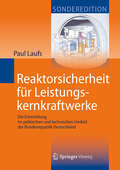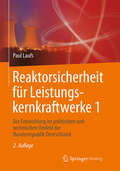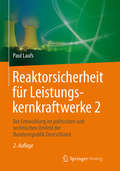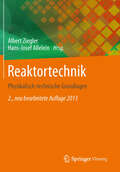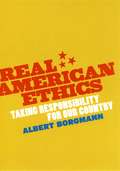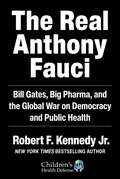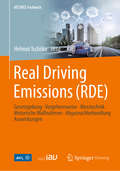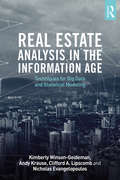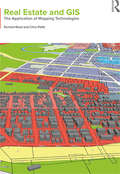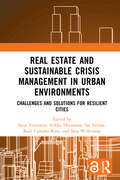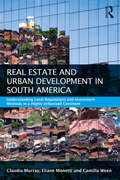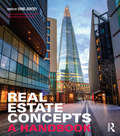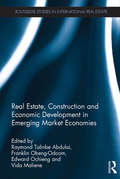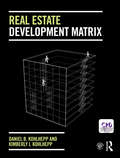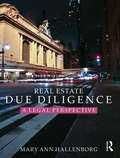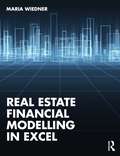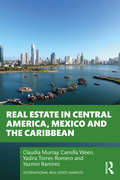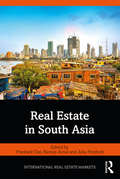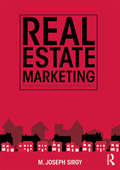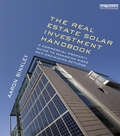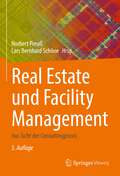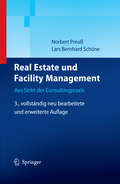- Table View
- List View
Reaktorsicherheit für Leistungskernkraftwerke
by Paul LaufsIn dem Band wird die Entwicklung der Reaktorsicherheit in deutschen Leichtwasser-Kernkraftwerken nachgezeichnet. Dabei wird auf die Rolle internationaler Vorbilder ebenso Bezug genommen wie auf nationale und internationale Risikostudien. Anhand des Beispiels Reaktorsicherheit wird deutlich, unter welchen politischen Bedingungen internationale Großforschungsprojekte entwickelt werden: Sicherheitsreserven und -kultur wurden in dem Moment verbessert, als die Frage der Nutzung der Kernenergie in das Zentrum der politischen Auseinandersetzungen rückte.
Reaktorsicherheit für Leistungskernkraftwerke: Die Entwicklung im politischen und technischen Umfeld der Bundesrepublik Deutschland
by Paul LaufsIn dem Band wird die Entwicklung der Reaktorsicherheit in deutschen Leichtwasser-Kernkraftwerken nachgezeichnet. Dabei wird auf die Rolle internationaler Vorbilder ebenso Bezug genommen wie auf nationale und internationale Risikostudien. Anhand des Beispiels Reaktorsicherheit wird deutlich, unter welchen politischen Bedingungen internationale Großforschungsprojekte entwickelt werden: Sicherheitsreserven und -kultur wurden in dem Moment verbessert, als die Frage der Nutzung der Kernenergie in das Zentrum der politischen Auseinandersetzungen rückte.
Reaktorsicherheit für Leistungskernkraftwerke 1
by Paul LaufsIn dem Band wird die Entwicklung der Reaktorsicherheit in deutschen Leichtwasser-Kernkraftwerken nachgezeichnet. Dabei wird auf die Rolle internationaler Vorbilder ebenso Bezug genommen wie auf nationale und internationale Risikostudien. Anhand des Beispiels Reaktorsicherheit wird deutlich, unter welchen politischen Bedingungen internationale Großforschungsprojekte entwickelt werden: Sicherheitsreserven und -kultur wurden in dem Moment verbessert, als die Frage der Nutzung der Kernenergie in das Zentrum der politischen Auseinandersetzungen rückte.
Reaktorsicherheit für Leistungskernkraftwerke 2
by Paul LaufsDas Werk beschreibt die wesentlichen Tätigkeitsfelder der Entwicklung der Kernenergienutzung im politischen und technischen Umfeld der Bundesrepublik Deutschland. Insbesondere die Entwicklung der Reaktorsicherheit deutscher Leichtwasser-Kernkraftwerke wird aus den Anfängen heraus mit ihren vielfältigen Bezügen zu ausländischen Vorbildern, zu nationalen und internationalen Forschungsvorhaben sowie zu konventionellen und nuklearen Schadensereignissen wiedergegeben.In diesem Band 2 werden die Sicherheitsfragen in Bezug auf die zentrale und wichtigste Komponente eines Kernkraftwerks vertieft, den Reaktordruckbehälter. Den in Deutschland verwendeten Reaktortechnologien werden zukünftige Optionen gegenübergestellt. Die hier vorliegende 2. Auflage enthält Ergänzungen, Korrekturen und neue Abbildungen. Neu bearbeitet wurden das Alterungsmanagement langjährig betriebener Anlagen, der Rückbau und die Entsorgung radioaktiver Abfälle.Detaillierte und reich bebilderte Darstellungen sind Kennzeichen der sachlichen Behandlung des Themas. Den in Band 1 dargestellten spezifischen Sicherheitstechniken, wie die Berstsicherheit der druckführenden Umschließung, die Sicherstellung der Notkühlung, die notwendige Leittechnik und der Umgebungsschutz, werden nun in Band 2 auch die detaillierten Betrachtungen des Alterungsmanagements, des Rückbaus von Kernkraftwerken und der Entsorgung radioaktiver Abfälle hinzugefügt. Die Inhalte schließen auch Ergebnisse nationaler und internationaler Risikostudien ein. Es wird gezeigt, wie die nationalen und internationalen Anstrengungen von Industrie, Staat und Wissenschaft zur Erhöhung der Sicherheitsreserven und zur Verbesserung der Sicherheitskultur in einem gesellschaftlichen Umfeld vorangetrieben wurden, in dem die Frage der Kernenergienutzung zu einem zentralen Thema der politischen Auseinandersetzungen wurde.
Reaktortechnik: Physikalisch-technische Grundlagen
by Albert Ziegler Hans-Josef AlleleinIm Buch Reaktortechnik werden die physikalisch-technischen Grundlagen und deren konkrete Umsetzung in Kraftwerken beschrieben. Nach der Darstellung der kernphysikalischen und thermohydraulischen Grundlagen beschreiben die Autoren Grundprinzipien und Aufbau bewährter Reaktorkonzepte ebenso wie die neuen Entwicklungen. Einen weiteren Schwerpunkt bilden Betrieb, Werkstoff- und Zuverlässigkeitsfragen. Abschließend gehen die Autoren auf den Brennstoffkreislauf vom Uranabbau bis zur Entsorgung ein. Motivation der Herausgeber war, den heutigen Stand des Wissens der Reaktortechnik zusammenzutragen und Ingenieuren in Studium und Praxis zugänglich zu machen. Das Buch basiert auf dem von Albert Ziegler herausgegebenen Standardwerk der Reaktortechnik. Das Buch eignet sich nicht nur als Lehrbuch für Studierende, sondern auch als Nachschlagewerk für die berufliche Praxis.
Real American Ethics: Taking Responsibility for Our Country
by Albert BorgmannAmerica is a wonderful and magnificent country that affords its citizens the broadest freedoms and the greatest prosperity in the world. But it also has its share of warts. It is embroiled in a war that many of its citizens consider unjust and even illegal. It continues to ravage the natural environment and ignore poverty both at home and abroad, and its culture is increasingly driven by materialism and consumerism. But America, for better or for worse, is still a nation that we have built. So why then, asks Albert Borgmann in this most timely and urgent work, are we failing to take responsibility for it? In Real American Ethics, Borgmann asks us to reevaluate our role in the making of American values. Taking his cue from Winston Churchill—who once observed that we shape our buildings, and then our buildings shape us—Borgmann considers the power of our most enduring institutions and the condition of our present moral makeup to propose inspired new ways in which we, as ordinary citizens, can act to improve our country. This, he shows, includes everything from where we choose to live and what we spend our money on to daunting tasks like the reshaping of our cities—habits and actions that can guide us to more accomplished and virtuous lives. Using prose that is easy and direct throughout, Borgmann’s position is grounded neither by conservative nor liberal ideology, but in his understanding that he is a devoted citizen among many. In an age in which the blame game is the only game in town, this patriotic book is an eloquent reminder of the political strength we all wield when we work together.
Real American Ethics: Taking Responsibility for Our Country
by Albert BorgmannAmerica is a wonderful and magnificent country that affords its citizens the broadest freedoms and the greatest prosperity in the world. But it also has its share of warts. It is embroiled in a war that many of its citizens consider unjust and even illegal. It continues to ravage the natural environment and ignore poverty both at home and abroad, and its culture is increasingly driven by materialism and consumerism. But America, for better or for worse, is still a nation that we have built. So why then, asks Albert Borgmann in this most timely and urgent work, are we failing to take responsibility for it? In Real American Ethics, Borgmann asks us to reevaluate our role in the making of American values. Taking his cue from Winston Churchill—who once observed that we shape our buildings, and then our buildings shape us—Borgmann considers the power of our most enduring institutions and the condition of our present moral makeup to propose inspired new ways in which we, as ordinary citizens, can act to improve our country. This, he shows, includes everything from where we choose to live and what we spend our money on to daunting tasks like the reshaping of our cities—habits and actions that can guide us to more accomplished and virtuous lives. Using prose that is easy and direct throughout, Borgmann’s position is grounded neither by conservative nor liberal ideology, but in his understanding that he is a devoted citizen among many. In an age in which the blame game is the only game in town, this patriotic book is an eloquent reminder of the political strength we all wield when we work together.
The Real Anthony Fauci: Bill Gates, Big Pharma, and the Global War on Democracy and Public Health (Children’s Health Defense)
by Robert F. Kennedy Jr.#1 on AMAZON, TWENTY WEEKS on the NEW YORK TIMES BESTSELLER LIST, and a WALL STREET JOURNAL, USA TODAY and PUBLISHERS WEEKLY NATIONAL BESTSELLEROver 1,000,000 copies sold despite censorship, boycotts from bookstores and libraries, and hit pieces against the author. Pharma-funded mainstream media has convinced millions of Americans that Dr. Anthony Fauci is a hero. Hands down, he is anything but. As director of the National Institute of Allergy and Infectious Diseases (NIAID), Dr. Anthony Fauci dispenses $6.1 billion in annual taxpayer-provided funding for rigged scientific research, allowing him to dictate the subject, content, and outcome of scientific health research across the globe—truly a dark agenda. Fauci uses the financial clout at his disposal in a back handed manner to wield extraordinary influence over hospitals, universities, journals, and thousands of influential doctors and scientists—whose careers and institutions he has the power to ruin, advance, or reward in an authoritarian manner. During more than a year of painstaking and meticulous research on his laptop and through interviews, Robert F. Kennedy Jr. unearthed a shocking story that obliterates media spin on Dr. Fauci . . . and that will alarm every American—Democrat or Republican—who cares about democracy, our Constitution, and the future of our children&’s health.The Real Anthony Fauci reveals how &“America&’s Doctor&” launched his career during the early AIDS crisis by partnering with pharmaceutical companies to sabotage safe and effective off-patent therapeutic treatments for AIDS. Fauci orchestrated fraudulent do-nothing studies, and then pressured US Food and Drug Administration (FDA) regulators into approving a deadly chemotherapy treatment he had good reason to know was worthless against AIDS. Fauci did the unthinkable and repeatedly violated federal laws to allow his Pharma partners to use impoverished and dark-skinned children as lab rats in beyond order, deadly experiments with toxic AIDS and cancer chemotherapies. In early 2000, Fauci shook hands with Bill Gates in the library of Gates&’ $147 million Seattle mansion, cementing a partnership that would aim to control an increasingly profitable $60 billion global vaccine enterprise with unlimited growth potential. Through funding leverage and carefully cultivated personal relationships with heads of state and leading media and social media institutions, the Pharma-Fauci-Gates alliance exercises dominion over global health policy and our beautiful country. This is not just another political book. The Real Anthony Fauci details how Fauci, Gates, and their cohorts use their control of media outlets—both conservative and liberal leaning, scientific journals, key government and quasi-governmental agencies, global intelligence agencies, and influential scientists and physicians to flood the public with fearful propaganda about COVID-19 virulence and pathogenesis, and to muzzle debate and ruthlessly censor dissent.
Real Driving Emissions: Gesetzgebung, Vorgehensweise, Messtechnik, Motorische Maßnahmen, Abgasnachbehandlung, Auswirkungen (ATZ/MTZ-Fachbuch)
by Helmut Tschöke Michael Arndt Michael Baade René Berndt Frank Bunar Boris Bunel Gernot Graf Markus Grubmüller Helmut Jansen Dieter Köhler Elisa-Maria Moser Lukas Walter Roland Wanker Friedemann Schrade Khai VidmarDas Buch beschreibt die Entwicklung der Abgas-Gesetzgebung und der Fahrzyklen, auch für die Verbrauchsmessung (CO2). Schwerpunkte sind die RDE-Gesetzgebung und die Vorgehensweise bei der Straßenmessung inklusive der dafür notwendigen mobilen Messtechnik (PEMS). Die komplizierte Bewertung der Messergebnisse wird verständlich dargestellt. Auch wenn der Pkw (Diesel und Benzin) im Vordergrund steht wird auch die praxisnahe Feldüberwachung (In Service Conformity) für Nutzfahrzeuge betrachtet. Mit der detaillierten Beschreibung von innermotorischen Maßnahmen und der Abgasnachbehandlung zur Reduzierung der Schadstoffemissionen erhält der Leser einen kompakten Überblick über die neueste Abgasgesetzgebung und die Reduzierung der Abgasschadstoffe für Fahrzeuge mit Verbrennungsmotoren. Am 3. Februar 2016 hat das Europäische Parlament das Gesetz zur Messung von Abgasschadstoffen unter realen Bedingungen auf der Straße beschlossen. Dieser sogenannte Real Driving Emissions Test (RDE) ist seit 1. September 2017 für die Messung der Stickoxide, der Partikelanzahl, der Kaltstartemissionen und der Emissionen von Hybridfahrzeugen für neue Fahrzeugmodelle Pflicht. Gleichzeitig wurde der praxisnähere Test-Zyklus WLTC anstelle des NEFZ eingeführt. Ein Jahr später gilt das Verfahren für alle neuen Fahrzeuge. Hintergrund der Messung unter realitätsnahen Bedingungen ist die zunehmende Diskrepanz zwischen den unter synthetischen Bedingungen (z.B. Fahrzyklus NEFZ) ermittelten geringen Emissionen und der nach wie vor unbefriedigenden Luftqualität (Immission), besonders in Regionen mit hoher Verkehrsdichte.
Real Engineering Experiments: 25+ Exciting STEAM Activities for Kids (Real Science)
by Anthony TegtmeyerSTEAM-powered experiments in engineering for kids ages 8 to 12 Learn about the amazing world of engineering for kids and how it works together with science, technology, art, and math. Whether you're experimenting with structures, materials, mechanics, or electrons, this book offers step-by-step instructions and full-color pictures that help you answer questions like "what can we use magnetism for?" and "how do catapults work?" This guide to engineering for kids features: Engineering explained—Dive deep into what it means to be an engineer as you learn about the different types of engineers and how they approach challenges. Amazing experiments—Build a robot, make your own battery, clean polluted water, create a wind-powered car, and more using basic items you might already have at home. Beginner guidance—Find explanations for why each experiment works, as well as suggestions for taking them even further. Explore the amazing world of engineering for kids with these fun experiments that will get kids excited about learning.
Real Estate Analysis in the Information Age: Techniques for Big Data and Statistical Modeling
by Kimberly Winson-Geideman Andy Krause Clifford A. Lipscomb Nick EvangelopoulosThe creation, accumulation, and use of copious amounts of data are driving rapid change across a wide variety of industries and academic disciplines. This ‘Big Data’ phenomenon is the result of recent developments in computational technology and improved data gathering techniques that have led to substantial innovation in the collection, storage, management, and analysis of data. Real Estate Analysis in the Information Age: Techniques for Big Data and Statistical Modeling focuses on the real estate discipline, guiding researchers and practitioners alike on the use of data-centric methods and analysis from applied and theoretical perspectives. In it, the authors detail the integration of Big Data into conventional real estate research and analysis. The book is process-oriented, not only describing Big Data and associated methods, but also showing the reader how to use these methods through case studies supported by supplemental online material. The running theme is the construction of efficient, transparent, and reproducible research through the systematic organization and application of data, both traditional and 'big'. The final chapters investigate legal issues, particularly related to those data that are publicly available, and conclude by speculating on the future of Big Data in real estate.
Real Estate and GIS: The Application of Mapping Technologies
by Richard Reed Chris PettitReal Estate and GIS focuses on the application of geographic information systems (GIS) and mapping technologies in the expanding property and real estate discipline. Whilst a thorough understanding of location is understood to be fundamental to the property discipline, real estate professionals and students have yet to harness the full potential of spatial analysis and mapping in their work. This book demonstrates the crucial role that technological advances can play in collecting, organising and analysing large volumes of real estate data in order to improve decision-making. International case studies, chapter summaries and discussion questions make this book the perfect textbook for property and applied GIS courses. Property and real estate professionals including surveyors, valuers, property developers, urban economists and financial analysts will also find this book an invaluable guide to the understanding and application of GIS technology within a real estate industry context.
Real Estate and Sustainable Crisis Management in Urban Environments: Challenges and solutions for resilient cities
by Sara Wilkinson Saija Toivonen Sirkka Heinonen Ira Verma Raúl Castaño-RosaThe aim of this book is to promote the dynamic resilience of societies by identifying, analysing, and exemplifying the role of space and land use in both anticipated and unanticipated primary and secondary crisis situations. The book brings together the expertise of a unique team of researchers and methods from fields of futures studies, land use planning, social sustainability and wellbeing, architecture, spatial planning, design and real estate economics, and presents a novel understanding of the direct and indirect impacts of possible crises in the space and land use context. It goes on to discuss the concept of resilience and exemplifies potential solutions and offers a holistic and forward-looking approach for crisis management through a lens of social sustainability and wellbeing, making an important contribution to the promotion of wellbeing in the built environment, especially in terms of land and residential space and building use. This book does not only identify barriers and successful incentives in resilient crisis management but also discusses the role of different stakeholders (e.g., households, office workers, real estate owners, space occupants, firms, the public sector, etc.) in crisis management. Finally, international case studies aiming to tackle the challenging landscape of future threats are presented, along with novel tools to support the development of future policies, regulations, and management practices in the built environment, which can increase the dynamic resilience of societies. Overall, this book is essential reading for decision-makers in the public and private sectors, urban developers, space and spatial designers, architects, planners, community stakeholders, real estate investors, facility managers and crisis and corporate responsibility managers.
Real Estate and Urban Development in South America: Understanding Local Regulations and Investment Methods in a Highly Urbanised Continent (Routledge International Real Estate Markets Series)
by Camilla Ween Claudia Murray Eliane MonettiReal Estate and Urban Development in South America uncovers how investors are navigating South American real estate markets in commercial, residential and infrastructure development. A preferred location for real estate development during the colonial era, in recent decades South America has been seen as high-risk for global real estate investors. This book explores the strengths and weaknesses of real estate markets in the region, concluding that with careful implementation of the correct development strategies, the region can once again take its place at the centre stage of global real estate investment. Comparing the economics and market maturity of South American countries in turn, the authors draw out the particular contexts in which investors and developers operate in mature and emerging markets. Bridging the gap between theory and practice, analysis of local development policies, legislation, valuation methods and taxation is supplemented with case studies from key players in the region’s major cities. The first full overview of real estate markets in South America, this book will be an essential guide for investors, policy makers, academics and students with an interest in this this rapidly evolving region.
Real Estate Concepts: A Handbook
by Ernie JowseyThe essential reference tool for all real estate, property, planning and construction students. Real Estate Concepts provides built environment students with an easy to use guide to the essential concepts they need to understand in order to succeed in their university courses and future professional careers. Key concepts are arranged, defined and explained by experts in the field to provide the student with a quick and reliable reference throughout their university studies. The subjects are conveniently divided to reflect the key modules studied in most property, real estate, planning and construction courses. Subject areas covered include: Planning Building surveying Valuation Law Economics, investment and finance Quantity surveying Construction and regeneration Sustainability Property management Over the 18 alphabetically arranged subject specific chapters, the expert contributors explain and illustrate more than 250 fully cross-referenced concepts. The book is packed full of relevant examples and illustrations and after each concept further reading is suggested to encourage a deeper understanding. This book is an ideal reference when writing essays, assignments and revising for exams.
Real Estate, Construction and Economic Development in Emerging Market Economies (Routledge Studies in International Real Estate)
by Raymond Talinbe Abdulai Franklin Obeng-Odoom Edward Ochieng Vida MalieneReal Estate, Construction and Economic Development in Emerging Market Economies examines the relationships between real estate and construction sectors and explores how each sector, and the relationships between them, affect economic development in emerging market economies (EMEs). Throughout the book, the international team of contributors discuss topics as diverse as real estate finance and investment, housing, property development, construction project management, valuation, sustainability and corporate real estate. In doing so the book demonstrates how the relationship between construction and real estate impacts on economic development in countries such as Argentina, Brazil, Colombia, China, Ghana, Nigeria, Turkey, Lithuania, Hungary and Slovenia. Topics include: the role of real estate brokerage in improving the living standards of citizens; the effect of a mineral boom on construction cycles, real estate values and the socio-economic conditions of people in boom towns and cities; corporate real estate management practices and how they affect economic growth; and the synergies between construction and real estate and how they, in turn, affect economic development. This book will be of interest to those studying and researching real estate, construction, development studies, urban economics and emerging market economies.
Real Estate Development Matrix: A Handbook
by Daniel B Kohlhepp Kimberly J. KohlheppThis book presents a new way of thinking about, teaching, learning, and practicing real estate development. Real Estate Development Matrix describes the process in a two-dimensional model and presents seven Development Stages which form the horizontal axis, and eight sets of Development Tasks which form the vertical axis to define a 56-cell matrix. In each cell, money is spent and risks are taken to achieve certain tasks and thereby create (or destroy) value. This holistic process considers the entire life cycle of real estate from its "green field" inception to its "brown field" state. The book is written by a real estate developer and academic, and the presented material is conceptual, practical, and non-technical. Jargon has been minimized as much as possible as the author introduces an entirely new model for real estate development that is both academically authoritative and developed in practice. It is aimed at a general professional audience participating in the development process, but equally the book is ideal for use as a textbook in undergraduate and graduate courses in real estate development, and an excellent supplemental text for business courses discussing real estate finance and investment. It may also be used as a textbook for professional courses, workshops, or seminars in real estate development. The book is supported by an interactive website at http://realestatedevelopmentmatrix.com/
Real Estate Due Diligence: A legal perspective
by Mary Ann HallenborgReal Estate Due Diligence is the first textbook on due diligence, the cornerstone of every successful real estate deal. Due diligence is designed to uncover potential risks posed by a real estate acquisition, financing, or development project and failure to carry it out successfully can result in costly oversights and diminished investment returns. This book demonstrates how to assess and manage legal risks on properties such as office buildings, shopping centres, industrial buildings, apartments, and hotels—before the transaction closes. Real estate students and practitioners are taken through all of the essential due diligence areas, including: Titles and ownership issues Zoning and land use Liens and mortgages Condition assessments Environmental and operational concerns And lease analysis Throughout the book, major laws and court cases are used to illustrate due diligence issues and provide rich opportunities for classroom study and discussion. Practice points and comprehensive due diligence checklists help readers to go on to put their learning in practice. This book fills a gap in the real estate literature and is perfect for use as a college textbook, a practitioner’s guide, or for industry training.
Real Estate Financial Modelling in Excel
by Maria WiednerGet ahead of your peers with Real Estate Financial Modelling in Excel, a book specifically designed to ensure that the next generation of property professionals become experts in the quantitative analysis of investments by teaching them how to create automated spreadsheets for the analysis of risk and return.Real estate financial modelling has become an essential skill to investment analysts as the global property industry has seen huge transformations as a result of more institutional investors, especially private equity funds, increasing their interest in the asset class. Consequently, the industry requires a new skill set from real estate professionals and graduates.Real Estate Financial Modelling in Excel will help current finance and real estate students, as well as practitioners, to harness the power of Microsoft Excel in the context of real estate investments and explain in an easy-to-follow manual style how to create financial models that will predict financial returns and the risks related to them. Readers will learn to use Excel for automation, data analysis, and data visualisation to inform their capital allocation decisions, giving them the edge with those technical skills in high demand in the investment markets and in particular with sophisticated investors such as pension and insurance funds, private equity, and specialised debt funds.This book will address the needs of busy real estate professionals and students in the final year of a real estate bachelor’s degree or master’s degree, who want to apply the theories of finance and investment into practice and build models to help make decisions regarding acquisitions, disposals, and management of real estate assets.
Real Estate in Central America, Mexico and the Caribbean (Routledge International Real Estate Markets Series)
by Claudia Murray Camilla Ween Yadira Torres-Romero Yazmin RamirezThis book examines real estate markets and urban development in Central America, Mexico and The Caribbean (CAMEC). It considers both residential and commercial real estate with a focus on industrial and hospitality sectors, infrastructure and logistics. The CAMEC region is besieged by complexity. Prone to natural disasters, and with the Mexico/US border constituting the largest human migration corridor on Earth, the region is also a vital trading hub for goods, linking commerce between the world’s two largest oceans and the Americas. The real estate markets in this area are dynamic, rapidly developing and under researched. This book analyses the particularities of these markets and the context in which investors and developers operate. The authors present case studies and contributions from key players in major cities in the region. The book exposes the regional risks and opportunities connected to urban development including market transparency, urban equity and development regulation. The research presented in this volume gives the reader a comprehensive picture of each country under study, detailing their individual commercial, residential, industrial, leisure and infrastructure sectors. This is essential reading for international investors, real estate students, researchers, and professionals with an interest in the region.
Real Estate in South Asia (Routledge International Real Estate Markets Series)
by Prashant Das Ramya Aroul Julia FreyboteThis book provides insights into commercial and residential real estate markets in one of the world’s fastest growing regions: South Asia. Despite being the growth leader of the future, South Asia is among the "least integrated" regions with a large need for real-estate-specific information and knowledge. Scholars and industry practitioners from a variety of backgrounds come together to provide pan-regional and country-specific insights into—amongst others—institutional, economic and real estate market characteristics, real-estate-specific legislation, real estate financing, development and urban planning practices in Bangladesh, Bhutan, India, the Maldives, Nepal, Pakistan and Sri Lanka. A particular focus of the book is on topics such as the provision of affordable housing, sustainability, innovative office concepts such as co-working and the development of real estate investment trust (REIT) markets in South Asia. This book integrates knowledge on real estate markets in and across South Asian countries by means of country profiles and case studies to provide industry professionals, policy makers and scholars with a fundamental understanding of characteristics, opportunities and challenges in the region. The book is intended for readers with interests in real estate development, finance and investment, urban planning and housing in South Asia. It is also suitable as a reference textbook for undergraduate and graduate students in programs focusing on real estate, economic development, urban planning and public policy in South Asia and other emerging countries.
Real Estate Marketing: Strategy, Personal Selling, Negotiation, Management, and Ethics
by M. Joseph SirgyReal Estate Marketing is specifically designed to educate real estate students with the art and science of the real estate marketing profession. The ideal textbook for undergraduate and graduate level classes in business school and professional / continuing education programs in Real Estate, this book will also be of interest to professional real estate entrepreneurs looking to boost their knowledge and improve their marketing techniques. The book is divided into five major parts. Part 1 focuses on introducing students to fundamental concepts of marketing as a business philosophy and strategy. Concepts discussed include strategic analysis, target marketing, and the four elements of the marketing mix: property planning, site selection, pricing of properties, and promotion of properties. Part 2 focuses on personal selling in real estate. Students will learn the exact process and steps involved in representing real estate buyers and sellers. Part 3 focuses on negotiations in real estate. How do effective real estate professionals use negotiation approaches such as collaboration, competition, accommodation, and compromise as a direct function of the situation and personalities involved in either buying or selling real estate properties? Part 4 focuses on human resource management issues such as recruiting and training real estate agents, issues related to performance evaluation, motivation, and compensation, as well as issues related to leadership. Finally, Part 5 focuses on legal and ethical issues in the real estate industry. Students will learn how to address difficult situations and legal/ethical dilemmas by understanding and applying a variety of legal/ethical tests. Students will also become intimately familiar with the industry’s code of ethics.
The Real Estate Solar Investment Handbook: A Commercial Property Guide to Managing Risks and Maximizing Returns
by Aaron BinkleyThe Real Estate Solar Investment Handbook explains the business case for property professionals to pursue solar projects. A project’s value is determined by its potential risks and rewards; these are explained thoroughly in terms understood by the real estate industry. This book provides a framework for practical decision-making, with each chapter addressing a step in the process, from project idea to completion. Written from the perspective of the commercial real estate industry professional, it will help investors evaluate opportunities and execute projects that offer solid risk-adjusted investments. For property owners, investors, landlords, service providers, and all those looking to invest in solar on commercial property, The Real Estate Solar Investment Handbook will guide you through all the steps needed to gain years of revenue from a project.
Real Estate und Facility Management: Aus Sicht der Consultingpraxis
by Hermann Maier Edgar Schropp Rainer Stiller Marina Bleifuß Wolfgang HögerleDie überarbeitete und deutlich erweiterte 5. Auflage dieses anerkannten Standardwerkes liefert einen umfassenden Einblick in die Grundsäulen des Real Estate und Facility Managements: Von der Projektentwicklung, dem Projektmanagement, über das Transaktions- und Risikomanagement bis hin zum Asset-, Property- und Facility Management. Alle wesentlichen Leistungen sowie Argumente für ein nachhaltiges Management der Sachwertanlage Immobilie, die hierfür notwendigen Strategien, Methoden sowie Vorgehensweisen werden detailliert dargelegt. Besonders informativ, anregend und aufschlussreich wird der Leser durch den interdisziplinären Ansatz sowie die umfangreichen aktuellen Beispiele, Tabellen und Abbildungen durch den Lebenszyklus der Immobilie geführt.Dieses Werk wendet sich seit nunmehr über 15 Jahren an drei Zielgruppen: Studenten, die sich mit den Grundlagen und den vertiefenden Aspekten der Bau- und Immobilienwirtschaft insgesamt oder mit einzelnen Elementen, wie etwa einer Portfolio-Analyse oder der Due Diligence, gezielt auseinandersetzen wollen; an Praktiker, die die aktuellen Entwicklungen ihres Fachgebiets verfolgen und eine fortwährende Aktualisierung ihres Wissenstandes anstreben sowie Wissenschaftler, die durch die kritische Reflexion der hier beschriebenen Expertisen Impulse für die Weiterentwicklung ihres Forschungsgebietes erhalten können.
Real Estate und Facility Management
by Lars Schöne Norbert PreußDie Autoren behandeln die Anforderungen an ein modernes Management im Sinne eines integrativen Ansatzes: vom Portfolio- und Property Management über die Projektentwicklung und das Projektmanagement bis hin zum Facility Management. Strategien und Methoden werden detailliert dargelegt. Aus der Praxis für die Praxis geschrieben, wendet sich das Buch an Consultants und Entscheider der Bau- und Immobilienwirtschaft, die an der Optimierung des Immobilienmanagements unter Rendite-, Risiko-, Kosten- und Nutzengesichtspunkten interessiert sind.
